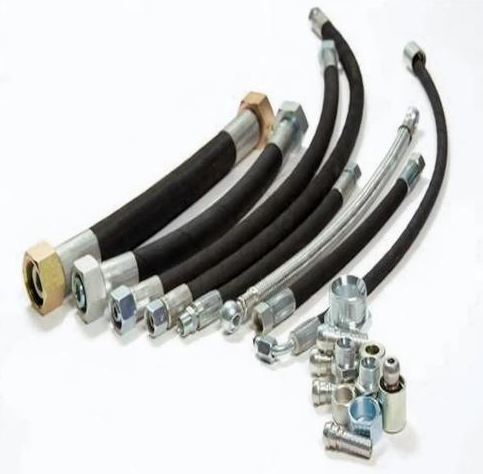
Steel wire wrapped oil resistant rubber hose
In the widespread application of modern construction machinery, oil pipes, as an important component of hydraulic systems, have a crucial impact on the performance and safety of equipment. This article will delve into the design, materials, performance characteristics, and application fields of steel wire spiral rubber hoses used in construction machinery, especially 6-layer high-pressure oil pipes, to help readers fully understand this key component.
1. Basic concepts of engineering machinery oil pipes
Engineering machinery oil pipes, especially high-pressure oil pipes, are pipelines used to transport hydraulic oil or other fluids. They play a role in transmitting pressure and power in hydraulic systems, ensuring that mechanical equipment can operate efficiently and stably. With the advancement of technology, the design and manufacturing of oil pipes are increasingly moving towards high performance and high safety.
2. Structure and performance of steel wire spiral rubber hose
The steel wire spiral rubber hose consists of an inner layer, a reinforcement layer, and an outer layer, with the reinforcement layer being the most important. For a 6-layer high-pressure oil pipeline, its construction structure usually includes:
-Inner layer: Made of high-quality synthetic rubber to ensure that the pipeline has good oil resistance and high temperature resistance, meeting the transportation needs of hydraulic oil.
-Enhancement layer: usually composed of multiple layers of high-strength steel wires arranged in a spiral manner, greatly enhancing the compressive and tensile strength of the pipeline, capable of withstanding pressures up to thousands of psi.
-Outer layer: Synthetic materials that are wear-resistant, weather resistant, and chemically resistant are usually used to increase the durability and adaptability of oil pipes.
This multi-layer structure design effectively improves the pressure resistance, wear resistance, and service life of the rubber hose, and can maintain good performance in harsh working environments. Therefore, it is widely used in various engineering machinery and equipment.
3. Application areas of 6-layer high-pressure oil pipes
6-layer high-pressure oil pipes are widely used in multiple fields due to their excellent performance and reliability, including:
-Construction machinery, such as excavators, bulldozers, loaders, etc., require high-speed and precise transmission of hydraulic power during operation.
-Agricultural machinery: In modern agriculture, the application of hydraulic systems makes the operation of agricultural machinery such as tractors and harvesters more efficient, improving productivity.
-Mining equipment: During the mining process, the equipment needs to withstand heavy loads and harsh environments. The application of 6-layer high-pressure oil pipes effectively ensures the safe operation of the equipment.
-Transportation equipment, such as forklifts and elevators, can efficiently solve transportation and handling problems.
4. How to choose a suitable high-pressure oil pipe
Choosing the appropriate high-pressure oil pipe is crucial for ensuring the normal operation of construction machinery. Factors to consider when making a purchase include:
-Pressure rating: Select appropriate oil pipes that meet pressure standards according to the equipment's usage requirements. 6-layer oil pipes are usually suitable for high-pressure environments.
-Temperature resistance range: Ensure that the selected oil pipe can operate safely within the temperature range experienced by the equipment during operation.
-Materials and Structure: Select high-quality materials and designs that have been certified and tested to ensure the durability and safety of the pipeline.
-Compatibility: Check the chemical compatibility of oil pipes with hydraulic oil and other liquids to avoid leakage caused by corrosion.
5. Maintenance and upkeep
Regular maintenance and upkeep are essential to extend the service life of high-pressure oil pipes. Here are some suggestions:
-Regular inspection: Conduct a comprehensive inspection of the oil pipe regularly, including appearance, connections, curvature, etc., and promptly address any issues found.
-Prevent excessive bending: During equipment operation, avoid excessive bending or twisting of the oil pipe to avoid affecting its performance.
-Cleaning and maintenance: Keep the oil pipe clean, avoid the accumulation of impurities and dirt, regularly apply protective agents, and prevent the aging of the outer material.
-Timely replacement: Once cracks, oil leaks, or severe wear are found in the oil pipe, it should be replaced in a timely manner to avoid causing greater losses.
6. Future Development Trends
With the continuous development of the construction machinery industry, major manufacturers are also constantly optimizing the design and manufacturing process of oil pipes. In the future, high-pressure oil pipes may develop in the following directions:
-Material innovation: Utilizing new composite materials to improve the lightweight and strength of oil pipes, further enhancing energy efficiency and performance.
-Intelligent monitoring: Through IoT technology, oil pipes will be equipped with sensors to monitor the status and usage of pipelines in real time, preventing accidents from occurring.
-Environmental design: Establish more environmentally friendly production processes, provide sustainable solutions for oil pipe materials and usage, and reduce environmental impact.
Conclusion
The steel wire spiral rubber hose in construction machinery, especially the 6-layer high-pressure oil pipe, is a key component to ensure the efficient and safe operation of hydraulic systems. Their structural design, performance characteristics, and wide range of application fields all demonstrate their importance in modern engineering machinery. By selecting appropriate oil pipes, regular maintenance, and monitoring new industry trends, we can effectively improve the efficiency and safety of equipment, thereby better meeting the growing engineering demands.